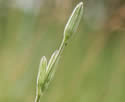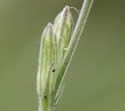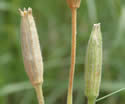Silene drummondii (Drummond's Campion)
| Also known as: | |
|---|---|
| Genus: | Silene |
| Family: | Caryophyllaceae (Pink) |
| Life cycle: | perennial |
| Origin: | native |
| Status: |
|
| Habitat: | sun; dry sandy soil or gravelly soil; prairies, plains, dunes, bluffs, hillsides, forest openings |
| Bloom season: | June |
| Plant height: | 8 to 24 inches |
| Wetland Indicator Status: | none |
| MN county distribution (click map to enlarge): |  |
| National distribution (click map to enlarge): |  |
Pick an image for a larger view. See the glossary for icon descriptions.
Detailed Information
Flower: 


![[photo of flower and calyx]](/udata/r9ndp23q/pd/silene-drummondii-062018-1-t.jpg) Three to 10+ stalked flowers in a loose cluster at the top of the stem. Flowers have 5 white to pinkish petals that are mostly hidden inside a tubular to elliptic calyx, with the petals barely poking out at the tip. The calyx is about ½ inch long, light green with 10 darker green veins and 5 erect, triangular lobes at the tip. Inside the tube are 10 stamens and 5 styles. Flower stalks are erect, of varying lengths. The calyx and stalks are covered in sticky, glandular hairs.
Three to 10+ stalked flowers in a loose cluster at the top of the stem. Flowers have 5 white to pinkish petals that are mostly hidden inside a tubular to elliptic calyx, with the petals barely poking out at the tip. The calyx is about ½ inch long, light green with 10 darker green veins and 5 erect, triangular lobes at the tip. Inside the tube are 10 stamens and 5 styles. Flower stalks are erect, of varying lengths. The calyx and stalks are covered in sticky, glandular hairs.
Leaves and stems: 


![[photo of basal leaves]](/udata/r9ndp23q/pd/silene-drummondii-062317-36-t.jpg) There is a basal rosette plus 2 to 5 pairs of opposite leaves along the stem. Leaves are toothless and covered in stiff, appressed hairs. Basal leaves are lance-elliptic to spatula-shaped, mostly widest near the middle, rounded to pointed at the tip, tapering to a stalk, up to ½ inch wide and 4 inches long including the stalk.
There is a basal rosette plus 2 to 5 pairs of opposite leaves along the stem. Leaves are toothless and covered in stiff, appressed hairs. Basal leaves are lance-elliptic to spatula-shaped, mostly widest near the middle, rounded to pointed at the tip, tapering to a stalk, up to ½ inch wide and 4 inches long including the stalk.
![[photo of upper stem leaves]](/udata/r9ndp23q/pd/silene-drummondii-080416-8-t.jpg) Stem leaves are lance-linear, 1 to 3½ inches long, up to about ¼ inch wide, stiff, erect and stalkless, the leaf pairs joined at the base. Stems are erect, unbranched, single or a few from the base, hairy, more densely so on the upper stem and sticky from glandular hairs.
Stem leaves are lance-linear, 1 to 3½ inches long, up to about ¼ inch wide, stiff, erect and stalkless, the leaf pairs joined at the base. Stems are erect, unbranched, single or a few from the base, hairy, more densely so on the upper stem and sticky from glandular hairs.
Fruit: 
![[photo of mature fruit]](/udata/r9ndp23q/pd/silene-drummondii-080516-s1-t.jpg) Fruit is a cylindric capsule about as long as the persistent calyx, opening at the top with usually 5 spreading teeth at the mouth. Inside are numerous seeds.
Fruit is a cylindric capsule about as long as the persistent calyx, opening at the top with usually 5 spreading teeth at the mouth. Inside are numerous seeds.
![[photo of seed]](/udata/r9ndp23q/pd/silene-drummondii-seed-080516-t.jpg) Seeds are less than 1 mm long, kidney-shaped, brown, covered in an intricate network pattern.
Seeds are less than 1 mm long, kidney-shaped, brown, covered in an intricate network pattern.
Notes:
Drummond's Campion is a dry prairie species that reaches the eastern edge of its US range in Minnesota. According to the DNR, this species prefers the semi-arid soil of grasslands or dunes, which are more abundant in the Great Plains but limited in Minnesota. The limited amount of suitable habitat combined with incompatible land use, such as ATV trails, puts species like Drummond's Campion at risk. It was listed as a Special Concern species in 1996.
It is a spindly plant and easily overlooked, but easily recognized once it is spotted. The cylindric, bud-like flowers that seem to never open, covered in sticky hairs, and a few pair of erect, opposite leaves are a distinct combination. There are two subspecies of Silene drummondii: subsp. striata is a western species of alpine meadows with flower petals distinctly longer than the calyx; subsp. drummondii is described above and is present in Minnesota.
Native Plant Nurseries, Restoration and Landscaping Services ↓
More photos
Photos by Peter M. Dziuk taken in Polk County.
Comments
Have you seen this plant in Minnesota, or have any other comments about it?







 Drummond's Campion plant
Drummond's Campion plant Drummond's Campion habitat
Drummond's Campion habitat flowers barely open
flowers barely open maturing fruit
maturing fruit